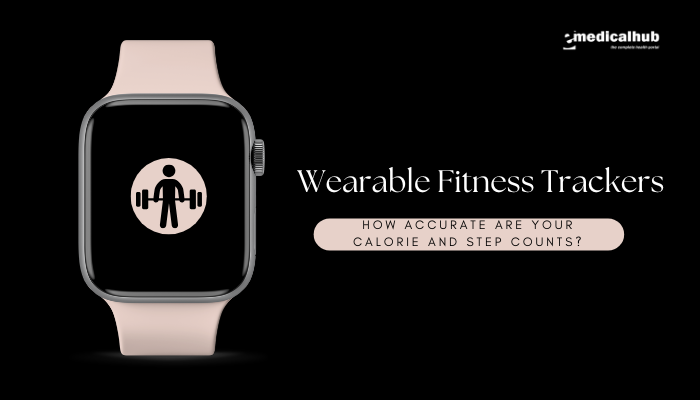Introduction
Wearable fitness trackers—think Fitbits, Apple Watches, Garmins, and a host of other wrist-mounted or clip-on devices—have surged in popularity for their ability to monitor steps, distance, heart rate, and estimated calorie expenditure. They promise real-time data that can motivate us to move more, eat smarter, or simply become more aware of daily habits.

Yet, if you’ve ever compared step counts between devices or questioned the calories “burned” shown on your watch, you’ve likely discovered that these trackers aren’t flawless. How precise are they really? Are the numbers enough to guide your diet and exercise decisions?
This article investigates how wearable fitness trackers measure steps and calories, exploring the technology behind them and the primary reasons for potential inaccuracies. We’ll highlight relevant studies, discuss common pitfalls in interpreting data, and offer tips on using wearable devices more effectively.
Ultimately, whether you’re aiming for 10,000 steps or trusting calorie estimates to manage weight, you’ll learn how to view these numbers with a balanced perspective—recognizing their benefits while acknowledging their limitations.
Disclaimer: The following content is for general informational use and does not replace personalized medical or nutritional advice. Always talk with a healthcare professional if you have specific health goals or concerns, especially regarding weight management or exercise regimens.
The Basics of How Wearables Track Steps and Calories
Step Counting: Accelerometers and Motion Sensors
Most modern wearables rely on accelerometers—tiny sensors that measure changes in velocity in three dimensions. They detect:
- Arm/Body Movement: Each swing or shake of your arm can be interpreted as a step, especially if the pattern matches walking or running strides.
- Algorithms: The device’s firmware uses algorithms to filter out extraneous motions (e.g., waving your arms in a conversation) and identify distinct footfalls.
Some advanced trackers incorporate gyroscopes or barometers to refine data by recognizing orientation or altitude changes (stairs vs. flat ground). Nevertheless, steps remain estimates. If you walk with minimal arm swing or push a cart, your tracker may undercount. Conversely, fidgeting or brushing your teeth vigorously might be miscounted as steps.
Calories Burned: Combining Movement and Biometrics
Calorie calculations are more complex. Devices typically integrate:
- Motion/Accelerometer Data: Estimate energy from the intensity of your steps or accelerations.
- Heart Rate Monitoring: Optical sensors measure pulse from your wrist. Higher heart rate suggests higher exertion.
- User Profile: Age, sex, weight, height—used to produce a baseline metabolic rate and estimate energy expenditure.
Then, internal algorithms combine these inputs to gauge “activity calories” (above your resting metabolism) plus an estimate for resting energy expenditure. Despite the sophistication, multiple factors—like personal metabolism, body composition, exercise type—can cause significant variation between the device’s estimates and your true energy burn.
How Accurate Are Step Counts?
Research Findings on Step Accuracy
Studies have tested various brands under controlled conditions:
- Wrist-based Trackers: Typically accurate within ±5–10% for steps in walking scenarios. The accuracy can drop if you’re running, doing elliptical training, or performing non-stepping movements.
- Hip/Belt Clip Devices: Historically more accurate because they align closely with lower-body movement, but less popular now.
- Arm Movements: Extra arm motion can produce false positives, while holding objects can lead to undercounts.
On average, most mainstream trackers do quite well with standard walking or running. However, random daily movements or exercises like cycling or weightlifting can lead to step detection errors because your arms might remain relatively still or move in non-rhythmic patterns.
Factors Affecting Step Count
- Wrist Placement: The non-dominant wrist often yields more consistent data, as the dominant arm is used for writing or other tasks that might introduce extraneous movement.
- Stride Patterns: If you have an unusual gait or stride length, standard algorithms might misinterpret movements.
- Intensity of Movement: Light taps or skipping might not be recognized, whereas jostling around might be overinterpreted as steps.
- Firmware Updates: Companies update their algorithms over time, potentially improving reliability or changing how steps are counted.
Minimizing Discrepancies
- Proper Wear: Snug fit on the recommended wrist, not too loose or rotating.
- Manual Adjustments: Some apps allow you to calibrate stride length or correct step data.
- Awareness: If your daily routine includes pushing a stroller or carrying items, you might want to keep the watch in your pocket or use an alternative method for counting steps.
Are Calorie Estimates Reliable?
Variation Across Devices
Calorie readouts often vary widely across different brands and models. Some research suggests:
- Inaccuracy Range: Errors can exceed ±20–50% in certain conditions.
- Better for Steady-State Activity: Devices might be more accurate for consistent walking or jogging on level ground. Complex movements—HIIT, weightlifting, or intervals—may see greater error.
- Overestimation or Underestimation: Some devices systematically overshoot or undershoot by hundreds of calories per day, enough to hamper weight management decisions.
Physiological Differences
The formulas typically assume average:
- Basal Metabolic Rate (BMR) based on height, weight, age, sex.
- Heart Rate–to–Calorie Relationship: Not everyone’s heart rate indicates the same caloric burn. For example, if you have higher fitness, you might achieve the same HR with less energy consumption compared to a less fit individual.
Also, personal factors like muscle mass, thyroid function, or genetics can significantly alter real energy expenditure compared to standard formula assumptions.
Impact for Weight Loss Goals
While it’s tempting to “eat back” your tracker’s reported calorie burn, trusting it blindly can sabotage weight loss if the device is overestimating. A better approach is to use the device’s calorie data as a rough gauge. Adjust based on actual progress: if your weight isn’t changing as anticipated, reevaluate your caloric intake or the reliability of that burn estimate.
Emerging Technologies and Improvements
Advanced Sensors (ECG, HRV)
Some high-end wearables incorporate:
- ECG Monitoring: More precise heart data can help estimate exertion more accurately.
- HRV Analysis: Heart Rate Variability insights might refine stress or recovery status, indirectly influencing daily calorie estimates.
- Accelerometer Upgrades: Enhanced sensor arrays or AI-driven posture/motion recognition could reduce movement miscount.
Multi-Point Body Tracking
- Smart Clothing: Embedded sensors in shirts or leggings gather extensive movement data. This might provide a better picture of total body activity, not just wrist motion.
- Data Fusion: Combining phone-based GPS, barometric altimeter for elevation changes, plus watch motion data yields improved accuracy, especially for runs or hikes.
Machine Learning Algorithms
Device manufacturers increasingly rely on machine learning that evolves with big user data sets, theoretically fine-tuning the relationship between heart rate, motion, and actual measured energy expenditure. Over time, improvements might yield more personalized estimates.
Practical Advice for Users
Setting Realistic Expectations
View step or calorie counts as guidelines or motivators, not absolute truths. Trends over time (are you more active this week than last?) can be more meaningful than the raw daily totals.
Focus on Patterns and Consistency
Monitor whether you’re achieving consistent daily movement or progressively increasing steps, rather than fixating on the absolute number. If your device says 8,000 steps consistently, but you add an extra walk, you see it climb to 9,500—progress is real, whether or not the exact count is perfect.
Use Additional Markers of Progress
- Clothes Fit: Are pants looser?
- Body Measurements: Waist circumference?
- Energy Levels: Are you more energetic or sleeping better?
- Performance Gains: Can you do more reps or longer runs?
These complement tracker data for a fuller picture.
Fine-Tune with Logging
If you want more accuracy:
- Manual Food Tracking: Pair your wearable data with a credible food logging approach. Over time, see if your theoretical deficit matches actual weight changes.
- Calibrate: Some trackers let you manually record treadmill or measured-run distances to refine step length.
- Use Heart Rate Zones: For workouts, track your perceived exertion vs. device’s feedback. If the device overstates your burn, adjust your diet accordingly.
Specific Scenarios
Athletes or High-Intensity Exercisers
- Interval and Strength Activities might not register well on step-based devices. They might underestimate calorie burn if the watch primarily calculates from steps. A chest-strap heart rate monitor or advanced watch with high-intensity detection might be better.
Sedentary Office Workers
The step count function can be a healthy reminder to stand up, walk around, or do short breaks. Even if it’s not 100% accurate, it’s enough to track daily movement increments.
Weight Management for Overweight or Obese Individuals
Using a wearable is beneficial for accountability and can reveal how daily steps correlate with weight changes over weeks. Just keep in mind the potential overestimation of calories. Rely on real progress or weigh-ins to confirm.
Common Myths
Myth 1: “If I hit 10,000 steps daily as per my tracker, I’ve guaranteed my recommended physical activity.”
Truth: 10,000 steps is an arbitrary target, though a decent general goal. The device’s step measure might be off, and intensity matters (e.g., 10k slow steps vs. brisk steps).
Myth 2: “I can eat the exact number of calories my watch says I burned.”
Truth: Over-reliance on that figure can lead to unintentional overeating if the watch overestimates. Monitor weight or use a modest approach (like eating back only half the “exercise” calories).
Myth 3: “More expensive trackers are always more accurate.”
Truth: Price can relate to advanced features but doesn’t guarantee perfect accuracy. Some mid-range models do well in step counts or HR metrics.
Frequently Asked Questions (FAQ)
- Can I improve step count accuracy by wearing the tracker on my ankle or shoe?
Potentially yes. Some runners use foot pods or ankle attachments for better distance or step data. However, it might compromise other features like HR monitoring from the wrist. - Are chest-strap heart rate monitors better than wrist-based?
Typically, yes. Chest straps measure electrical signals from the heart, generally more accurate than wrist optical sensors for intense or rapid HR changes. But for daily step or resting HR, wrist-based sensors suffice for many. - My device never matches the calorie burn on gym machines. Which is right?
Both can be off. Treadmill or elliptical estimates vary widely. Focus on a consistent method or measure trends—like using the same device or machine over time for relative comparison, rather than absolute values. - If I wave my arms around without walking, will it record steps?
Possibly. That’s an example of false positives. Some trackers are better at filtering out extraneous arm motion. - Do wearable trackers help with long-term weight loss success?
Some evidence shows that consistent self-monitoring (like wearing a tracker) can boost accountability. However, success depends on sustained healthy eating, portion control, and the user’s motivation.
Conclusion
Wearable fitness trackers have become staples for many seeking to quantify their daily activity and calorie burn, promising instant feedback that can foster motivation. Their step counts are typically fairly reliable for simple walking or running, though they may falter for non-step-based exercises. Calorie estimates are more prone to error, as they hinge on general formulas, variable heart rate responses, and user info. Nonetheless, these devices still provide a helpful ballpark measure for most everyday purposes.
If your goal is improved health or weight management, you can still benefit greatly from these trackers by viewing them as motivational tools and guidelines rather than precise scientific instruments. Focus on trends—improving step averages over time, noticing increased daily movement, or correlating calorie estimates with real-world results (like actual weight changes). Ensure that your approach merges the data with your subjective experience, consistency in diet quality, and mindful portion sizes. With a balanced perspective, wearable devices can be an empowering addition to your fitness routine, driving you toward more active habits and a better understanding of your body’s signals—even if the exact numbers aren’t perfect to the calorie or step.
References
- Evenson KR, Goto MM, Furberg RD. Systematic review of the validity and reliability of consumer-wearable activity trackers. Int J Behav Nutr Phys Act. 2015;12:159.
- Bunn JA, Navalta JW, Fountaine CJ, et al. Current state of commercial wearable technology in physical activity monitoring. Prog Prev Med. 2019;4(5).
- Brooke SM, An HS, Kang SK, et al. Concurrent validity of wearable activity trackers. BioMed Res Int. 2017;2017:2329758.
- Shcherbina A, Mattsson CM, Waggott D, et al. Accuracy in wrist-worn, sensor-based measurements. PLoS One. 2017;12(2):e0171720.
- Bassett DR, et al. Step counting: A review of measurement considerations and health-related applications. Sports Med. 2017;47(7):1303-1315.
- Chowdhury EA, Western MJ, Nightingale TE, et al. Assessment of wearable devices measuring energy expenditure. BMC Public Health. 2017;17(1):136.
- Creasy SA, et al. Quality of consumer devices for measuring metabolic equivalents (METs). J Sports Sci Med. 2020;19(4):738-748.
- Halse RE, et al. The relationship between wearable accuracy and weight management. Obesity Rev. 2018;19(7):862-869.
- Cadmus-Bertram L, et al. The effect of wearable technology combined with a lifestyle intervention. JAMA. 2016;316(11):1161-1171.
- Fokkema T, Kooiman TJ, Krijnen WP, et al. Reliability and validity of 10 consumer activity trackers. BMC Sports Sci Med Rehabil. 2017;9:24.
- Piwek L, Ellis DA, Andrews S, et al. The rise of consumer health wearables. PLoS Med. 2016;13(2):e1001953.
- Freedson PS, Miller K. Objective monitoring of physical activity. Med Sci Sports Exerc. 2000;32(9 Suppl):S457-S474.






